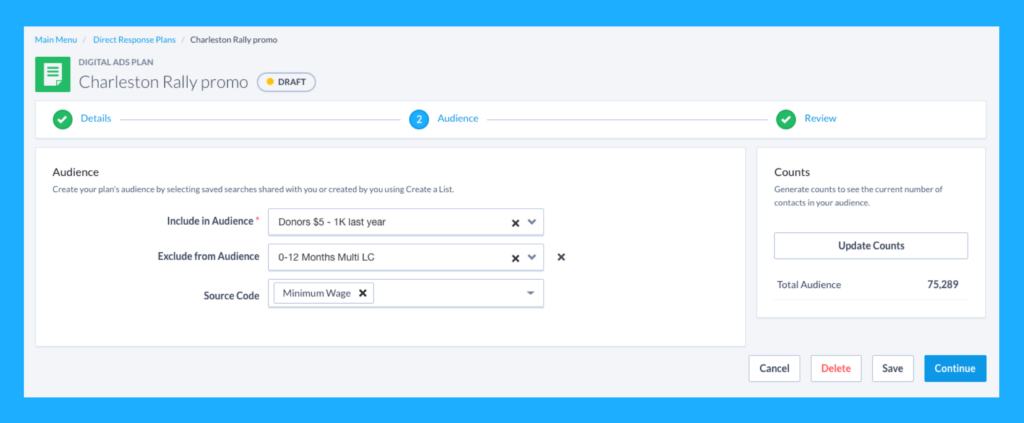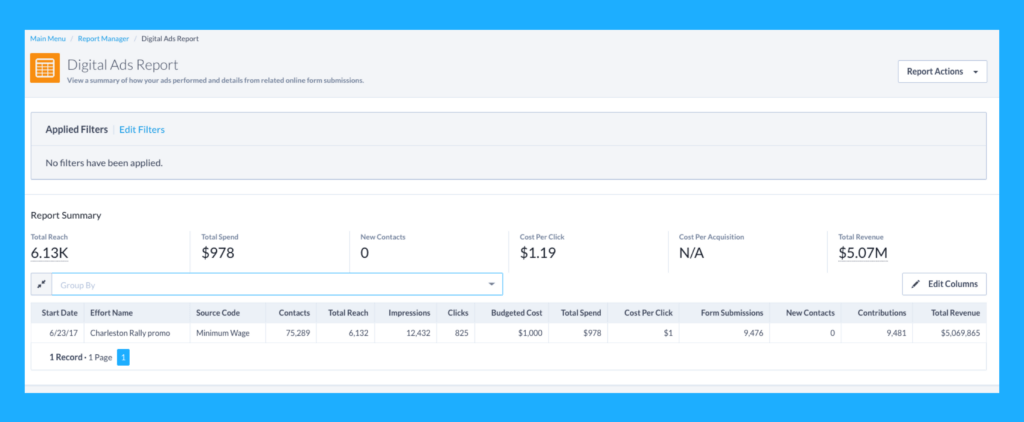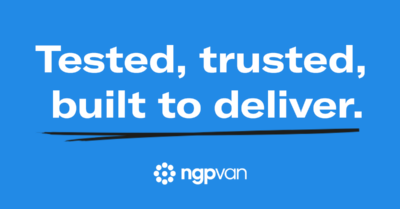7 Ad Targeting Strategies to Support Your Political Campaign

To run a successful political campaign, you need a comprehensive digital strategy that uses multiple online channels to get your message in front of voters. Along with organic channels like email and social media, you can strategically reach a broader (or more specific) audience using ad targeting.
This article will explore the basics of political ad targeting and introduce seven strategies that Democratic and progressive campaigns can use to get their messages in front of the right audiences.
What is Political Ad Targeting?
Ad targeting is a method of using data and technology to find the most precise audience that is likely to view, engage, or interact with your campaign’s advertisements.
Factors like demographics, location, online behavior, and ad viewing history all affect how likely a user is to interact with your ad. By segmenting your audience based on this data and leveraging social media tools like Facebook Ads Manager, you can determine which users to show your campaign ads to.
Political ad targeting can help you boost awareness of key issues, grow your support base, raise more funds for your campaign, and inspire supporters and voters to take action.
Top Ad Targeting Strategies for Political Campaigns
Ad targeting can take many forms, and some are more successful than others. These are the top strategies we’ve found to be the most effective for political campaigns:
1. Engage Supporters Through Facebook Ads Manager
Political campaigns are increasingly finding new ways to engage supporters on Facebook, and one key way is to use Facebook Ads Manager to guide their ad targeting. Especially for down-ballot candidates, Facebook Ads are a precise, cost-effective way to communicate a message to a highly specific audience.
Facebook Ads Manager allows you to create three audience categories for your ads:
- Core audiences are your main target users who don’t yet know about your campaign. You can select a broad audience for your ads and then narrow it down by location, age, gender, language, and interests.
- Custom audiences are made up of those who have already visited one of your pages, engaged with your profile, or taken a specified action. Choose a “source” this audience should have interacted with before, such as your website, an event registration page, or something else that resonates with your audience type.
- Lookalike audiences use your custom audiences as a source to find new, similar audiences. All you have to do is select a custom audience and location, and Facebook will show your ads to new users with similar characteristics and behaviors.
For even better results, use a tool like NGP VAN’s Digital 8 that integrates with Facebook Ads Manager. When you integrate Facebook Ads with your supporter database, you can automatically sync your existing audiences with Facebook custom audiences to lessen your staff’s workload and see faster ad results.
2. Leverage Audience Insights
You know how important it is to learn about your supporters’ interests and opinions through voter and donor research. In addition to helping you find the right audiences to target, Facebook Ads Manager can help you learn more about them.
Facebook Ads Manager’s Audience Insights feature provides information about your following’s online behavior by showing you other pages that your selected audience engages with and some demographic information. You can then leverage this data to create more specific, relevant advertisements that resonate more with your followers.
3. Segment Your Audience to Ensure Ads Are Relevant
Another ad targeting strategy that ensures your ads’ relevance is segmentation. Segment your audience based on shared characteristics like age, donation frequency, and location. Then create advertisements that line up with that segment’s specific interests.
For example, using NGP VAN’s Facebook Ads integration, you can create a list of supporters in VAN, NGP, or Digital 8 and segment your list by including or excluding certain attributes:

To drum up additional support for their Charleston rally, this fictional campaign chose to include a designated audience that they created based on donation totals and exclude another audience to create their targeted group to advertise to. While only a portion of the campaign’s overall supporters, the selected segment still represents a large number of people—on the right side, you can see that the segment includes over 75,000 contacts. By creating segments that are specific but not too small, your campaign can create ads that are highly relevant to key audiences who can help you make progress toward your goals.
4. Perfect Your Ad Copy
Once you have a thorough understanding of your various target audiences, focus on your actual advertisements. Use all the insights you’ve gained about your audience from the above strategies to write ad copy that resonates with them.
Along with tailoring ad copy to your audience’s interests, follow these best practices to write copy that engages readers:
- Convey urgency.
- Appeal to emotions like hope, gratitude, or anger.
- Write clear, straightforward calls to action.
- Center your audience and how they can make a difference.
- Grab readers’ attention with short and compelling copy.
For example, a political fundraising ad written using these strategies might look like this:
Kids like Destiny shouldn’t have to go to school in fear. You can help protect students by electing lawmakers who fight for gun restrictions, not against them. Donate just $10 to [Campaign] to make a difference for our children.
5. Try A/B Testing
If you’ve created several ads but aren’t sure which one will stand out to your target audience, use A/B testing to find out. A/B testing involves showing a select group of supporters two different versions of an advertisement to see which one they respond to better.
Finding out which version of your campaign ads are more persuasive, more engaging, or more interactive helps you make decisions about which ads to prioritize your spending on and gives insight into how to optimize future advertisements.
6. Use Retargeting
Retargeting is the practice of advertising to users who have already seen or interacted with your content, such as those who visited your website or started filling out a donation form. By showing your ads to these users, you’ll remind them to dive back into learning about your campaign, signing up for your email list, or completing a donation.
Create custom audiences in Facebook Ads Manager that retarget users who have taken specific actions. You might create one custom audience for those who have visited your website and another for users who filled out an email sign-up form. Then, monitor how successful your retargeting efforts are at achieving your goals and adjust your ad copy if needed.
7. Pay Attention to Your Metrics
Consistently monitoring your ads’ success metrics is crucial to analyze your return on investment. Pay special attention to metrics in relation to your goals like:
- Impressions
- Click-through rate
- Conversions
- Total ad spend
- Cost per click
- Email list sign-ups
- Return on ad spend (ROAS)
If you use NGP VAN’s Facebook Ads integration, you can see the results of your ad campaign in a robust Digital Ads Report. The report’s default settings will show your efforts from the past year, or you can use additional filters to look at specific efforts, designations, or campaigns.
For digital ad plans that lead to an Online Actions form, the report also breaks down your results into contributions from new contacts, targeted contacts from your advertising effort, and excluded existing contacts. That helps candidates monitor their ROI from a given ad campaign.
Take a look at the example results below for a fictional ad campaign promoting a rally:

Based on the ad spend and total revenue earned from this fictional candidate’s ad campaign, they can determine that their ad targeting was successful and emulate those tactics in future ad campaigns.
Improve Your Ad Targeting Strategies with NGP VAN’s Integration
You can find success with these strategies by using NGP VAN’s Social Network Integration. The integration helps you improve your ad targeting, measure the results, and use your ads to effectively increase supporter participation and engagement. Most powerfully, this allows you to track the ROI of your ad campaigns over time, letting you easily review the results of your advertising campaigns along with other important engagement metrics.
Schedule a demo to see how our Social Network Integration can improve your ad targeting and help you get elected.



